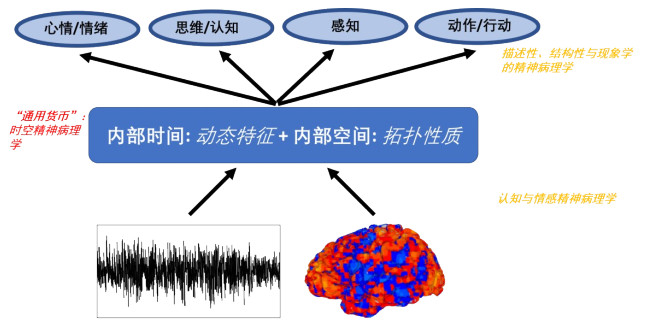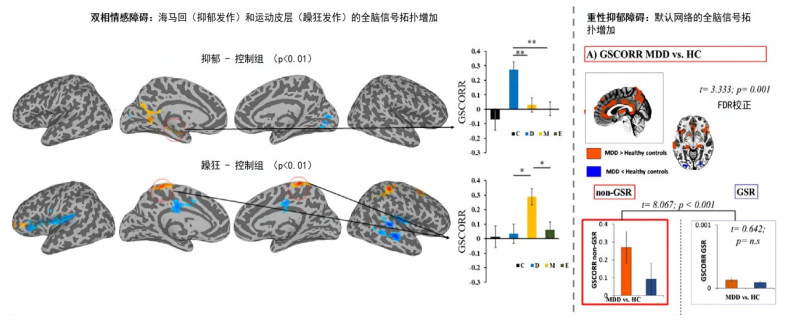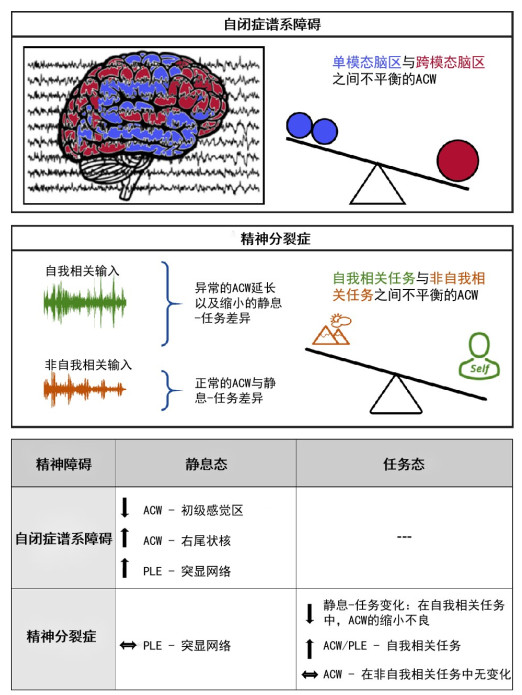The Link Between Brain and Symptoms in the Perspective of Spatiotemporal Psychopathology
-
摘要: 我们是如何描述精神病理症状并将其与大脑联系起来的?目前,大部分关于精神病理症状的研究通常只关注症状本身或主要关注大脑,却忽略了精神病理症状与大脑的密切联系。而时空精神病理学(Spatiotemporal Psychopathology,SPP)提供了一种新的方法去研究精神病理症状与大脑的关系,它假设:大脑神经活动的内部时空组织为精神病理症状提供了时空组织。具体而言,大脑的神经拓扑性质和时间动态特征或多或少表现出与心理层面类似的时空组织,即心理拓扑性质和动态特征。重度抑郁症、双相情感障碍、精神分裂症和自闭症等精神疾病的研究均提供了强有力的证据支持这一假设。因此,我们得出结论,时空精神病理学为探索大脑和精神病理症状的密切联系提供了一种有前景的方法。Abstract: How can we characterize psychopathological symptoms and connect them to the brain? Current psychopathological symptoms only focus on either the symptoms themselves or predominantly on the brain. This leaves open their intimate connection. A novel approach, spatiotemporal psychopathology, proposes that the brain inner spatiotemporal organization of its neural activity provides the spatiotemporal organization of the psychopathological symptoms. Specifically, the brains' neuronal topography and dynamic is manifest in a more or less analogous spatiotemporal organization on the mental level, i. e., mental topography and dynamic. This is strongly supported by various examples including major depressive disorder, bipolar disorder, schizophrenia, and autism. We therefore conclude that spatiotemporal psychopathology provides a promising approach to intimately connect brain and symptoms.
-
Keywords:
- brain /
- psychopathological symptoms /
- spatiotemporal psychopathology /
- schizophrenia /
- depression
-
一. 引言
一 将精神病理症状与大脑联系起来
目前,精神病学面临的一个关键挑战是如何理解精神病理症状,即如何描述这些症状并将其与大脑的异常联系起来。精神病理学涉及经验和理论框架,在这个框架中描述、归类精神病患者的症状、行为和个人经验[1-5]。由此,精神病理学形成了不同分支,包括描述性精神病理学、结构性精神病理学和现象学精神病理学[1-3, 6-10]。
精神病理学的不同分支着重于对症状本身的理解,并结合个体和其周围环境进行解释。尽管描述性、结构性和现象学方法存在差异,但它们都有共同的心理学框架:精神病理学症状主要用心理学的现象学术语来解释,重点使用第一人称和第二人称的方法,以便在更广泛的社会和文化背景下认识个体的经验以及理解精神病理症状的意义[7, 10]。
神经科学和生物精神病学的迅速发展使我们有必要将精神病理症状和精神病理学更普遍地与大脑的神经机制联系起来。然而,主要利用第一或第二人称方法的描述性、结构性和现象学的精神病理学似乎与大脑第三人称的客观研究相悖。为了将精神病理学与神经科学结合起来,需要一种第三人称(非第一或第二人称)的方法,而认知精神病理学[11]和情感精神病理学[12]就提供了这种方法。
认知和情感精神病理学认为,精神病理学症状主要是大脑的各种认知和情感功能障碍。例如,重度抑郁症(major depression disorder,MDD)的各种病理症状被认为与认知情绪调节障碍有关,是前额叶皮层(prefrontal cortex)对杏仁核(amygdala)自上而下的调节能力下降所导致的[13]。而情感精神病理学主张MDD是一种情绪障碍,与源于皮质下核(subcortical nuclei)的寻求系统(SEEKING system)的功能障碍有关[12]。
尽管以往的研究已取得一定进展,但大脑和精神病理症状的直接联系仍不明确。目前,我们仍然不清楚大脑产生各种精神病理症状的确切神经机制。具体而言,缺乏基于第一人称和第二人称的症状(即个体的经验和意义)与基于第三人称的对大脑神经机制的客观观察之间的联系,而研究二者密切联系的方法是寻找它们的共同点,即“通用货币”(common currency)[14]。
二 时间-空间是大脑和精神病理症状的“通用货币”
神经特征(neural features)和心理特征(mental features)的共同点是什么?尽管二者存在差异,但神经特征和心理特征共享基本的时空组织或结构[14-15]。大脑的自发活动在其神经活动中构建了“内在时间和空间”(inner time and space,区别于世界的“外在时间和空间”)[14, 16-17];这种内在时间和空间反过来又出现在精神病理症状(包括其第一人称体验)的时间和空间结构中。
速度(speed)是大脑和精神病理症状之间“通用货币”的原型例子。抑郁症患者的内在时间异常缓慢,表现为情绪、社会行为、心理活动和认知的异常缓慢[6]。内在时间感知的速度下降和各种精神病理症状都与神经加工水平的速度下降有关,即神经活动作为神经元速度的指标表现出低的变异性[18]。因此,异常缓慢的速度是抑郁症的大脑和抑郁症病理症状所共有的,即它们之间的“通用货币”[14, 18-19]。
因此,为了将精神病理症状与大脑联系起来,我们可能需要基于最近提出的“时空精神病理学”(Spatiotemporal Psychopathology,SPP)[8-9, 15, 18, 20],从空间和时间两方面来描述它们。SPP假设特定的空间和时间结构作为“通用货币”被大脑的神经活动和精神病理症状所共享。精神病理症状不再被视为认知或情感障碍,而是大脑内部的时空紊乱(包括大脑内部如何与外部时间和空间相对应,见图 1)。
SPP认为,大脑内部时空结构的变化为认知、感觉、运动和情感功能提供了一个异常的时空包络或框架。正如现象学精神病理学所述,这种异常的时空包络或框架表现为个体对时间和空间的感知或体验[1-4, 6-7, 10, 21]。因此,现象学精神病理学可能会提供一个重要的方法论,将大脑的时空结构与精神疾病症状的时空组织紧密联系起来。
如何描述大脑和精神疾病症状的时间和空间结构特点?空间结构指的是大脑中不同脑区和脑网络之间的组织,可称为大脑的拓扑结构。时空精神病理学提出,大脑的神经拓扑结构体现在精神病理症状的空间组织中;也就是说,它们相互耦合的方式(症状耦合,symptom coupling)相当于一个“心理拓扑”[22]。在时间方面也是如此,不同时间尺度的脑活动是以某种方式组织的,类似的组织方式也表现在症状的心理层面中——即神经动态特征浮于心理动态表面(neuronal dynamic surfaces in mental dynamic)。
二. 从神经拓扑到心理拓扑——精神病理症状的空间组织
一 大脑的内部空间及其全脑拓扑
大脑的内部空间表现出一种特殊的组织和层次结构,即“内部神经空间”(inner neuronal space)。这种内部神经空间表现为一种特殊的神经拓扑,将大脑的内部空间与外部空间区分开[23-24]。与世界外部空间的感知和认知相关的神经关联物的研究有许多[23-24],但大脑的内部空间,即“操作空间”(operational space)最近才获得关注[25]。
如何才能测量大脑的全脑活动,从而测量其内部空间?一种测量大脑持续活动的方法是测量fMRI中的全脑信号(global signal,GS)[26-29]。然而,当提及GS时,研究人员首先面临的争议是是否从fMRI信号中去除全脑信号[26-27, 30-31]。许多研究建议从fMRI的静息态和任务态数据中回归全脑信号[26, 28, 32-34],这是因为研究者认为GS与神经元外的呼吸等单纯噪声有关[26, 28, 35-36]。然而,最近的证据指出,GS不是单纯的非神经元噪声和伪迹;相反,其具有重要的生理功能,可能涉及认知功能[29-30, 37-40]。正如我们推测的那样,GS似乎是生理性的,反映了“真正的”神经活动,可能作为神经元基线介导正在进行的脑神经活动。
一些研究将fMRI中的GS与电生理测量相结合,主要应用于猴子[27, 41-46]以及人类的研究[44]。GS具有关键的电生理特征,它与不同频带的功率具有不同的相关关系。例如,相比较低频(0.1—1Hz)和较高频(1—100Hz),GS与次低频(infraslow frequency ranges,IFS < 0.1Hz)有更高的相关[41-42, 45]。
这些研究都提示了,GS不是单纯的非神经元噪音,而是基于“真实的”神经元活动。具体而言,这些结果表明,GS是由周期长的次低频活动(< 0.1Hz)主导的,而较高频活动对其影响较小。低频和高频对全脑信号的不同作用似乎是频率范围和皮层距离的一个函数。一些研究表明,delta/theta频带(1—8Hz)活动和较高频(40—80Hz)活动对皮层水平上的神经活动具有较广泛的影响,GS就是一个例子[27, 42, 44]。
相较之下,alpha/beta频带(10—30Hz)活动不遍及全脑,而是局限在视觉皮层和丘脑中[27, 41, 44, 46]。相应地,频率越低,GS测量的全脑神经活动影响所涉及的皮层越广泛,同时其影响越强[27, 41, 44, 46]。
在精神障碍个体中,大脑的全脑神经拓扑结构的变化是否以异常的方式塑造了个体经验和认知的组织?基于“通用货币”的理论[14],SPP假设神经水平上的拓扑变化(即神经元拓扑)以一种或多或少的方式相应地重新出现在认知上,即心理拓扑。为这一假设提供支持的是时空精神病理学在空间维度上的主要目标,以下将展开讨论。
二 精神分裂症患者的异常全脑信号及其拓扑结构
相比健康个体,精神分裂症个体的GS及其拓扑均发生变化。Yang等人在两个精神分裂症个体中首次观察到全脑GS值的显著升高[47-48]。除了GS的水平,在后来的研究中也观察到精神分裂症个体的拓扑差异。Yang等人发现,精神分裂症患者的感觉运动脑网络中的GS值显著减小,而在高级联想网络中网络的GS值则显著增加[47]。此外,在健康受试者中,低阶感觉运动网络和高阶关联网络的GS值存在负相关,而这种负相关在精神分裂症患者中则显著减弱。在另一项研究中,Wang等人发现这种拓扑可以被细分为不同的状态,其子状态的动态交替与临床量表指标相关[49]。
然而,关于精神分裂症的研究结果并不完全一致。Argyelan等人研究发现,未用药的精神分裂症患者全脑功能连接下降[50-51],这也与认知任务加工速度下降相关(也发现关于精神分裂症中GS值减小的类似结果)[52]。前面提及的不一致结果可能与测量GS拓扑的方法不同有关:Yang等人在研究中使用了beta值进行全脑信号回归,而其他研究采用了全脑连接或全脑信号中非神经元噪声的不同权重等方式[47]。
这些研究都提示,精神分裂症在低阶感觉脑区和高阶认知脑区的GS及其空间拓扑存在异常。GS拓扑的异常变化可能导致各种异常的感知和认知行为,如内部和外部导向认知的混淆,这是典型的精神分裂症症状,如妄想、思维障碍、被动现象(passivity phenomena)、幻听和自我障碍[22, 53-54]。
三 其他精神疾病中的全脑信号拓扑异常
与精神分裂症中GS值升高不同,双相情感障碍(bipolar disorder,BD)的全脑信号水平正常[51, 55]。然而,双相情感障碍患者的GS拓扑存在异常。Zhang等人的研究显示,躁狂发作BD中,运动皮层的GS值升高,这很可能与它们的运动活动(motor activity)增加有关,即精神运动性激动(psychomotor agitation)[55]。而在抑郁发作BD中,海马体GS值升高,这可能与患者的自传体记忆回忆增加有关。因此,GS拓扑的异常变化可能与行为和认知的相应变化或失衡有关,如运动活动和记忆提取的改变或失衡(见图 2)。
我们假设BD患者在静息态下可能存在“类任务态”的状态,即海马体(抑郁发作BD)和运动皮层(躁狂发作BD)在静息态下GS值可能会升高,而一般情况下只有任务态中GS值才升高(如运动或自传性记忆回忆任务期间[29, 55])。如果研究结果发现BD患者任务态脑活动减弱,静息态与任务态之间差异较小或没有差异[22],则该假设成立。
其他精神疾病的研究中也存在GS拓扑的改变,如自闭症[56]和多动症[57],还有一种情况是重度抑郁症(MDD)。在临床上,MDD的特点是内部导向的认知活动增加,如心智游移(即反刍和自我参照),这通常与默认网络(default-mode network,DMN)的脑区或网络活动增加有关。此外,以往研究提示GS与内侧前额叶皮层和海马等DMN的异常相关,这些脑区与抑郁病理症状相关,并能预测治疗效果[58-62]。
最近,Scalabrini等人的研究表明,DMN脑区功能连接异常与GS拓扑的改变有关[58]。在MDD中,其他脑网络与DMN的功能连接显著高于健康受试者(DMN似乎“奴役”着其他脑网络)。此外,DMN与其他脑网络功能连接强度(异常的GS拓扑结构)可有效预测临床诊断结果(机器学习准确率达90%)。这些发现提示了,GS拓扑可能向DMN发生全脑到局部的异常转换,而且在DMN中,这种全脑信号表征的增强是以非DMN的表征为代价的(见图 2)。
在GS拓扑向DMN转换后,MDD的行为也可能从非DMN的外部导向认知转移到异常强烈的内部导向认知表征,这反映为我们所观察到的MDD症状,如心智游移的增加(反刍、自我参照思维以及自我中心思想)。因此,我们假设异常GS拓扑及其从非DMN到DMN的转换可能与自闭症患者转向内部导向认知密切相关,如以牺牲外部导向认知(减少以环境为中心的感知)为代价增强自我中心、心智游移和自传性记忆提取[8, 19]。
三. 从神经动态特征到心理动态特征——精神病理症状的时间组织
一 大脑的内在时间——神经动态特征
大脑的内在时间是怎样的?大脑的自发神经活动可以划分为不同频带,即从次低频(0.01—0.1Hz)、低频(0.1—1Hz)、高频(1—40Hz)到超高频(40—180Hz)[63]。次低频的功率最强,并随着频率升高按照幂律分布递减[64-66]。不同的频带及其功率共同构成了大脑自发活动的复杂时间结构,这种复杂时间结构在很大程度上可以通过次低频、低频和高频之间的平衡来体现。
频带之间的关系在不同的时间尺度上保持不变,因此称为“无尺度动态特征”(scale-free dynamics)[64-65, 67]。这种无尺度活动描述了分形(自相似)组织,即功率与不同频带之间关系的时间嵌套性,也就是周期较长、功率较强的低频脑活动嵌套,并包含周期较短和功率较低的高频脑活动,被称为在不同的时间尺度或频带上的长时程相关(long-range temporal correlation,LRTC)[64-65, 67-68]。
LRTC可用于评估过去的神经活动模式对未来时间动态特征影响的程度[67-68]。它类似于一种记忆的形式,这里的记忆不是指被编码、存储和回忆或提取的具体内容,而是指结构,即不同时间点的神经活动的时间结构。因此,也可以称为时间记忆或动态记忆,即基于过程和结构的记忆,而区别于传统意义上主要基于内容的认知记忆[69-70]。LRTC所测量的无尺度活动不仅通过其对不同时间尺度相关性的影响提供时间稳定性,而且通过连接过去、未来和现在的时间提供时间记忆(即时间连续性)。
大脑内部时间的另一个特点是具有不同时间尺度。静息态下的神经活动构成了不同的时间窗口,称为“内在神经时间尺度”(intrinsic neural timescales,INT)[71-73]。INT的时间窗口指的是神经活动随着时间的推移与自身自动相关的程度,它可以通过自相关窗口(autocorrelation window,ACW)测量。研究表明,INT有一个层级拓扑结构,在单模态感觉皮层,INT较短;而在跨模态联合皮层,如前额叶皮层可以观察到较长的INT[71, 74-75]。
为什么大脑的内部时间可以影响认知活动?它又是如何影响的?最近的研究表明,LRTC和INT都是介导意识[76-80]和自我[66, 81]的关键。由于在各种精神疾病中,意识和自我都发生了异常变化,大脑的内在时间与其LRTC和INT可能是理解精神病理症状的关键。具体而言,在“通用货币”假设的框架下[14],SPP假设大脑神经动态的变化或多或少表现类似精神病理症状动态的变化(即心理动态),而为这一假设提供支持是时空精神病理学在时间维度上的主要目标。
二 自闭症的内在时间神经尺度
内在时间神经尺度与个体行为表现和认知加工有关吗?关于精神疾病的研究提供了相关的证据。最近一项静息态fMRI研究利用自相关窗口(ACW)研究自闭症个体的内在时间神经尺度[82]。该研究发现,与健康受试者相比,成年自闭症谱系障碍(ASD)个体初级感觉皮层(视觉、感觉运动、听觉)的ACW值显著减小,并且与ASD的严重程度呈负相关。相比之下,ASD患者右尾状核的ACW值显著增加,这也与ASD患者的刻板行为的程度相关。随后,青少年儿童ASD个体fMRI静息态的研究在相同脑区也观察到类似的ACW变化以及相关结果,这提示内在时间神经尺度可能存在一个发展过程。这些结果也得到另一项fMRI静息态研究的进一步支持[83]。此外,研究者还计算了PLE(power law exponent)和频谱熵,结果发现ASD在突显网络(salience network,SN)的特定脑区(脑岛、前扣带皮层上部、丘脑)中PLE值增加以及低频活动功率增强,而精神分裂症受试者在SN中没有发现PLE值增加。其他测量方法(如局部一致性,regional homogeneity,REHO)和神经变异性(neural variability,以SD为指标)在ASD中没有发现差异。这些结果表明,内在时间神经尺度可作为ASD、精神分裂症和其他精神疾病鉴别诊断的神经指标[83-84]。
三 精神分裂症的内在时间神经尺度
最近有一项关于精神分裂症的脑电研究发现,大部分急性期后首发患者(post-acute first-episode)在卷入自我特异性加工的任务(enfacement task)中,几个电极的ACW值异常增长(以及PLE值异常高)[22]。该研究还发现,精神分裂症患者ACW值在静息态与任务态之间的差异显著减小,即与健康受试者不同,他们在任务态中ACW几乎没有缩短。该结果得到了100名精神分裂症患者的EEG大样本的进一步证实。另外,相比健康受试者,精神分裂症患者在听觉oddball范式中相位一致性降低。
ACW的异常延长是否与精神病理症状有关?Northoff等人[85]应用中介模型表明,ACW介导了精神分裂症的自我障碍和精神病理症状之间的关系。正如Watanabe等关于自闭症的研究所述[82],这些研究共同支持一个假设:内在时间神经尺度的变化可能与精神病理症状有关,更普遍地说,与精神分裂症的行为和认知有关。
最近一项关于精神分裂症的fMRI研究也进一步支持了这一假设。Wengler[86]等人研究表明,在感觉输入流(听觉、视觉、体感)中,精神分裂症患者不再存在从外周到更中心脑区的渐进式分层增长的INT。换句话说,与低阶感觉皮层相比,这些患者在高阶多模态脑区不再显示更长的INT。
重要的是,感觉输入流两端(单模态、多模态)的平衡在幻觉症状和妄想症状中存在相反的模式,表明特定症状具有拓扑动态特异性[86]。而另一项研究利用fMRI进一步验证INT分层增长的假设[87],他们也发现了精神分裂症的体感和视觉输入脑区INT的异常变化,这种变化也与症状严重程度相关。
总之,这些发现强有力地证明了精神分裂症INT存在异常变化(包括INT与病理症状如自我障碍、妄想、幻觉以及整体症状严重程度的关系)。因此,INT和其他测量时间动态特征的指标有望成为病理症状特异性指标,以及自闭症、精神分裂症和抑郁症等的诊断关键[83, 88](见图 3)。
四. 结论
目前,精神病理学的一个关键问题是仍然缺乏对精神病理症状的正确理解,以及症状如何与大脑的神经变化相联系。由此,人们研究精神病理学的各种分支,包括侧重于症状本身的经验,以及更多地关注将症状与大脑的认知功能联系起来,这些研究使大脑和症状相联系成为可能。
时空精神病理学提供了一种新的方法将大脑和精神病理症状联系起来。具体来说,时空精神病理学提出,大脑和病理症状共享一个潜在的空间和时间组织作为“通用货币”[14-15]。时空精神病理学将焦点转移到大脑的内部时间和空间,即神经动态和拓扑,以及它们如何体现在精神病理症状的空间和时间组织中,即神经和心理拓扑。
本文总结了这种时空精神病理在各种精神疾病中的例子,包括抑郁症、双相情感障碍、精神分裂症和自闭症等。尽管还处在起步阶段,时空精神病学仍提供了一种有前景的方法,通过时空(拓扑和时间动态)将大脑和病理症状联系起来。这不仅在理论上更有助于对精神病理症状的深入理解,而且也可以应用到临床诊断和最终的治疗干预上。
-
-
[1] PARNAS J, SASS L A, ZAHAVI D. Recent developments in philosophy of psychopathology[J]. Current opinion in psychiatry, 2008, 21(6): 578-584. doi: 10.1097/YCO.0b013e32830e4610
[2] PARNAS J, SASS L A, ZAHAVI D. Rediscovering psychopathology: the epistemology and phenomenology of the psychiatric object[J]. Schizophrenia bulletin, 2013, 39(2): 270-277. doi: 10.1093/schbul/sbs153
[3] STANGHELLINI G. A hermeneutic framework for psychopathology[J]. Psychopathology, 2009, 43(5): 319-326.
[4] STANGHELLINI G. The meanings of psychopathology[J]. Current opinion in psychiatry, 2009, 22(6): 559-564. doi: 10.1097/YCO.0b013e3283318e36
[5] STANGHELLINI G, BROOME M R. Psychopathology as the basic science of psychiatry[J]. The british journal of psychiatry, 2014, 205(3): 169-170. doi: 10.1192/bjp.bp.113.138974
[6] FUCHS T. Temporality and psychopathology[J]. Phenomenology and the cognitive sciences, 2013, 12(1): 75-104. doi: 10.1007/s11097-010-9189-4
[7] GIOVANNI S, MATTHEW B, ANTHONY V F. The Oxford handbook of phenomenological psychopathology[M]. New York: Oxford Unviersity Press, 2018: 1-1184.
[8] NORTHOFF G. Spatiotemporal psychopathology I: is depression a spatiotemporal disorder of the brain's resting state?[J]. Journal of affective disorder, 2016, 190: 854-866. doi: 10.1016/j.jad.2015.05.007
[9] NORTHOFF G. Spatiotemporal psychopathology II: how does a psychopathology of the brain's resting state look like?[J]. Journal of affective disorder, 2016, 190: 867-879. doi: 10.1016/j.jad.2015.05.008
[10] STANGHELLINI G, BALLERINI M. What is it like to be a person with schizophrenia in the social world? A first-person perspective study on Schizophrenic dissociality——part 1: state of the art[J]. Psychopathology, 2011, 44(3): 172-182. doi: 10.1159/000322637
[11] HALLIGAN P W, DAVID A S. Cognitive neuropsychiatry: towards a scientific psychopathology[J]. Nature reviews neuroscience, 2001, 2(3): 209-215. doi: 10.1038/35058586
[12] PANKSEPP J. Textbook of biological psychiatry[M]. New York: Wiley Online Library, 2004: 1-736.
[13] SHEPPES G, SURI G, GROSS J J. Emotion regulation and psychopathology[J]. Annual review of clinical psychology, 2015, 11: 379-405. doi: 10.1146/annurev-clinpsy-032814-112739
[14] NORTHOFF G, WAINIO-THEBERGE S, EVERS K. Is temporo-spatial dynamics the "common currency" of brain and mind? In quest of "spatiotemporal neuroscience"[J]. Physics of life reviews, 2020, 33: 34-54. doi: 10.1016/j.plrev.2019.05.002
[15] NORTHOFF G, WAINIO-THEBERGE S, EVERS K. Spatiotemporal neuroscience-what is it and why we need it[J]. Physics of life reviews, 2020, 33: 78-87. doi: 10.1016/j.plrev.2020.06.005
[16] IMMANUEL K. Critique of pure reason[M]. Cambridge: Cambridge University Press, 1998: 1-784.
[17] NORTHOFF G. From emotions to consciousness - a neuro-phenomenal and neuro-relational approach[J]. Frontiers in psychology, 2012, 3: 303.
[18] NORTHOFF G. The brain's spontaneous activity and its psychopathological symptoms-"Spatiotemporal binding and integration"[J]. Progress in neuro-psychopharmacology and biological psychiatry, 2018, 80(Pt B): 81-90.
[19] NORTHOFF G, WIEBKING C, FEINBERG T E A. The "resting-state hypothesis" of major depressive disorder-a translational subcortical-cortical framework for a system disorder[J]. Neuroscience and biobehavioral reviews, 2011, 35: 1929-1945. doi: 10.1016/j.neubiorev.2010.12.007
[20] FINGELKURTS A A F A. Brain space and time in mental disorders: paradigm shift in biological psychiatry[J]. International journal of psychiatry in medicine, 2019, 54(1): 53-63. doi: 10.1177/0091217418791438
[21] BROOME M R, ZÁNYI E, HAMBORG T, et al. A high-fidelity virtual environment for the study of paranoia[J]. Schizophrenia research and treatment, 2013, 63: 538185.
[22] NORTHOFF G. "Common currency" between experience and brain: spatiotemporal psychopathology of the resting state in depression[J]. Advances in experimental medicine and biology, 2021, 1305: 71-84.
[23] BUZSÁKI G, LLINÁS R. Space and time in the brain[J]. Science, 2017, 358(6362): 482-485. doi: 10.1126/science.aan8869
[24] DRAYTON L, FURMAN M. Thy mind, thy brain and time[J]. Trends in cognitive sciences, 2018, 41(10): 641-643.
[25] FINGELKURTS A A, FINGELKURTS A A, NEVES C F. Natural world physical, brain operational, and mind phenomenal space-time[J]. Physics of life reviews, 2010, 7(2): 195-249. doi: 10.1016/j.plrev.2010.04.001
[26] LIU T T, NALCI A, FALAHPOUR M. The global signal in fMRI: nuisance or information?[J]. Neuroimage, 2017, 150: 213. doi: 10.1016/j.neuroimage.2017.02.036
[27] LIU X, ZHANG N, CHANG C, et al. Co-activation patterns in resting-state fMRI signals[J]. Neuroimage, 2018, 180: 485-494. doi: 10.1016/j.neuroimage.2018.01.041
[28] POWER J D, PLITT M, LAUMANN T O, et al. Sources and implications of whole-brain fMRI signals in humans[J]. Neuroimage, 2017, 146: 609-625. doi: 10.1016/j.neuroimage.2016.09.038
[29] ZHANG J, HUANG Z, TUMATI S, et al. Rest-task modulation of fMRI-derived global signal topography is mediated by transient coactivation patterns[J]. PLoS biolology, 2020, 18: 1-22.
[30] MURPHY K, FOX M D. Towards a consensus regarding global signal regression for resting state functional connectivity MRI[J]. Neuroimage, 2017, 154: 169-173. doi: 10.1016/j.neuroimage.2016.11.052
[31] LIU T T. Noise contributions to the fMRI signal: an overview[J]. Neuroimage, 2016, 143: 141-151. doi: 10.1016/j.neuroimage.2016.09.008
[32] CHAI X J, CASTAÑÁN A N, ÖNGÜR D, et al. Anticorrelations in resting state networks without global signal regression[J]. Neuroimage, 2012, 59: 1420-1428. doi: 10.1016/j.neuroimage.2011.08.048
[33] NALCI A, RAO B D, LIU T T. Global signal regression acts as a temporal downweighting process in resting-state fMRI[J]. Neuroimage, 2017, 152: 602-618. doi: 10.1016/j.neuroimage.2017.01.015
[34] WONG C W, OLAFSSON V, TAL O, et al. Anti-correlated networks, global signal regression, and the effects of caffeine in resting-state functional MRI[J]. Neuroimage, 2012, 63: 356-364. doi: 10.1016/j.neuroimage.2012.06.035
[35] BIRN R M, DIAMOND J B, SMITH M A, et al. Separating respiratory-variation-related fluctuations from neuronal-activity-related fluctuations in fMRI[J]. Neuroimage, 2006, 31: 1536-1548. doi: 10.1016/j.neuroimage.2006.02.048
[36] BIRN R M, SMITH M A, JONES T B, et al. The respiration response function: the temporal dynamics of fMRI signal fluctuations related to changes in respiration[J]. Neuroimage, 2008, 40: 644-654. doi: 10.1016/j.neuroimage.2007.11.059
[37] ORBAN C, KONG R, LI J, et al. Time of day is associated with paradoxical reductions in global signal fluctuation and functional connectivity[J]. PLoS biolology, 2020, 18: e3000602. doi: 10.1371/journal.pbio.3000602
[38] UDDIN L Q. Mixed signals: on separating brain signal from noise[J]. Trends in cognitive sciences, 2017, 21: 405-406. doi: 10.1016/j.tics.2017.04.002
[39] UDDIN L Q. Bring the noise: reconceptualizing spontaneous neural activity[J]. Trends in cognitive sciences, 2020, 24: 734-746. doi: 10.1016/j.tics.2020.06.003
[40] LI J, BOLT T, BZDOK D, et al. Topography and behavioral relevance of the global signal in the human brain[J]. Scientific reports, 2019, 9(1): 14286. doi: 10.1038/s41598-019-50750-8
[41] SCHOLVINCK M L, MAIER A, YE F Q, et al. Neural basis of global resting-state fMRI activity[J]. Proceedings of the national academy of sciences of the United States of America, 2010, 107: 10238-10243. doi: 10.1073/pnas.0913110107
[42] SCHOLVINCK M L, SALEEM A B, BENUCCI A, et al. Cortical state determines global variability and correlations in visual cortex[J]. Journal of neuroscience, 2015, 35: 170-178. doi: 10.1523/JNEUROSCI.4994-13.2015
[43] TURCHI J, CHANG C, YE F Q, et al. The basal forebrain regulates global resting-state fMRI fluctuations[J]. Neuron, 2018, 97: 940-952. doi: 10.1016/j.neuron.2018.01.032
[44] WEN H, LIU Z. Broadband electrophysiological dynamics contribute to global resting-state fMRI signal[J]. Journal of neuroscience, 2016, 36: 6030-6040. doi: 10.1523/JNEUROSCI.0187-16.2016
[45] LEOPOLD D A, MURAYAMA Y, LOGOTHETIS N K. Very slow activity fluctuations in monkey visual cortex: implications for functional brain imaging[J]. Cerebral cortex, 2003, 13(4): 422-433. doi: 10.1093/cercor/13.4.422
[46] CHANG C, LEOPOLD D A, SCHÖLVINCK M L, et al. Tracking brain arousal fluctuations with fMRI[J]. Proceedings of the national academy of sciences of the United States of America, 2016, 113(16): 4518-4523. doi: 10.1073/pnas.1520613113
[47] YANG G J, MURRAY J D, GLASSER M, et al. Altered global signal topography in schizophrenia[J]. Cerebral cortex, 2017, 27: 5156-5169.
[48] YANG G J, MURRAY J D, REPOVS G, et al. Altered global brain signal in schizophrenia[J]. Proceedings of the national academy of sciences of the United States of America, 2014, 111: 7438-7443. doi: 10.1073/pnas.1405289111
[49] WANG X, LIAO W, HAN S, et al. Altered dynamic global signal topography in antipsychotic-naive adolescents with early-onset schizophrenia[J]. Schizophrenia research, 2019, 208: 308-316. doi: 10.1016/j.schres.2019.01.035
[50] ARGYELAN M, GALLEGO J A, ROBINSON D G, et al. Abnormal resting state fMRI activity predicts processing speed deficits in first-episode psychosis[J]. Neuropsychopharmacology : official publication of the American college of neuropsychopharmacology, 2015, 40: 1631-1639. doi: 10.1038/npp.2015.7
[51] ARGYELAN M, IKUTA T, DEROSSE P, et al. Resting-state fMRI connectivity impairment in schizophrenia and bipolar disorder[J]. Schizophrenia bulletin, 2014, 40: 100-110. doi: 10.1093/schbul/sbt092
[52] HAHAMY A, CALHOUN V, PEARLSON G, et al. Save the global: global signal connectivity as a tool for studying clinical populations with functional magnetic resonance imaging[J]. Brain connectivity, 2014, 4: 395-403. doi: 10.1089/brain.2014.0244
[53] PARNAS J. The core gestalt of schizophrenia[J]. World psychiatry, 2012, 11: 67-69. doi: 10.1016/j.wpsyc.2012.05.002
[54] NORTHOFF G, DUNCAN N W. How do abnormalities in the brain's spontaneous activity translate into symptoms in schizophrenia? From an overview of resting state activity findings to a proposed spatiotemporal psychopathology[J]. Progress in neurobiology, 2016, 145-146: 26-45. doi: 10.1016/j.pneurobio.2016.08.003
[55] ZHANG J, MAGIONCALDA P, HUANG Z, et al. Altered global signal topography and its different regional localization in motor cortex and hippocampus in mania and depression[J]. Schizophrenia bulletin, 2019, 45: 902-910. doi: 10.1093/schbul/sby138
[56] GOTTS S J, SIMMONS W K, MILBURY L A. Fractionation of social brain circuits in autism spectrum disorders[J]. Brain, 2012, 135: 2711-2725. doi: 10.1093/brain/aws160
[57] ABBAS A, BASSIL YS. K. Quasi-periodic patterns of brain activity in individuals with attention-deficit/hyperactivity disorder[J]. Neuroimage: clinical, 2019, 21: 101653. doi: 10.1016/j.nicl.2019.101653
[58] SCALABRINI A, VAI B, POLETTI S E A. All roads lead to the default-mode network-global source of dmn abnormalities in major depressive disorder[J]. Neuropsychopharmacology : official publication of the American college of neuropsychopharmacology, 2020, 45: 2058-2069. doi: 10.1038/s41386-020-0785-x
[59] ABDALLAH C G, AVERILL C L, AL S R E. Prefrontal connectivity and glutamate transmission: relevance to depression pathophysiology and ketamine treatment[J]. Biological psychiatry: cognitive neuroscience and neuroimaging, 2017, 2: 566-574. doi: 10.1016/j.bpsc.2017.04.006
[60] SCHEINOST D, HOLMES S E, DELLAGIOIA N E A. Multimodal investigation of network level effects using intrinsic functional connectivity, anatomical covariance, and structure-to-function correlations in unmedicated major depressive disorder[J]. Neuropsychopharmacology : official publication of the American college of neuropsychopharmacology, 2018, 43: 1119-1127. doi: 10.1038/npp.2017.229
[61] ZHANG L, WU H, XU J E A. Abnormal global functional connectivity patterns in medication-free major depressive disorder[J]. Frontiers in neuroscience, 2018, 12: 692. doi: 10.3389/fnins.2018.00692
[62] MURROUGH J W, ABDALLAH C G, ANTICEVIC A E A. Reduced global functional connectivity of the medial prefrontal cortex in major depressive disorder[J]. Human brain mapping, 2016, 37: 3214-3223. doi: 10.1002/hbm.23235
[63] BUZSÁKI G. Rhythms of the Brain[M]. New York: Oxford University Press, 2006: 1-464.
[64] HE B J, ZEMPEL J M, SNYDER A Z, et al. The temporal structures and functional significance of scale-free brain activity[J]. Neuron, 2010, 66: 353-369. doi: 10.1016/j.neuron.2010.04.020
[65] HE B J. Scale-free brain activity: past, present, and future[J]. Trends in cognitive sciences, 2014, 18(9): 480-487. doi: 10.1016/j.tics.2014.04.003
[66] HUANG Z, OBARA N, DAVIS H P J, et al. The temporal structure of resting-state brain activity in the medial prefrontal cortex predicts self-consciousness[J]. Neuropsychologia, 2016, 82: 161-170. doi: 10.1016/j.neuropsychologia.2016.01.025
[67] LINKENKAER-HANSEN K, NIKOULINE V V, PALVA J M, et al. Long-range temporal correlations and scaling behavior in human brain oscillations[J]. Journal of neuroscience, 2001, 21: 1370-1377. doi: 10.1523/JNEUROSCI.21-04-01370.2001
[68] NORTHOFF G, HUANG Z, How do the brain's time and space mediate consciousness and its different dimensions? Temporo-spatial theory of consciousness (TTC)[J]. Neuroscience and biobehavioral reviews, 2017, 80: 630-645. doi: 10.1016/j.neubiorev.2017.07.013
[69] HASSON U, CHEN J, HONEY C J. Hierarchical process memory: memory as an integral component of information processing[J]. Trends in cognitive sciences, 2015, 19: 304-313. doi: 10.1016/j.tics.2015.04.006
[70] NORTHOFF G. Personal identity and cortical midline structure (CMS): do temporal features of CMS neural activity transform into "self-continuity"?[J]. Psychological inquiry, 2017, 28: 122-131. doi: 10.1080/1047840X.2017.1337396
[71] GOLESORKHI M, GOMEZ-PILAR J, TUMATI S, et al. Temporal hierarchy of intrinsic neural timescales converges with spatial core-periphery organization[J]. Communications biology, 2021, 4: 1-14. doi: 10.1038/s42003-020-01566-0
[72] GOLESORKHI M G-P J, ZILIO F, BERBERIAN N, et al. The brain and its time: intrinsic neural timescales are key for input processing[J]. Communications biology, 2021, 16: 970.
[73] WOLFF A, BERBERIAN N, GOLESORKHI M, et al. Intrinsic neural timescales: temporal integration and segregation[J]. Trends in cognitive sciences, 2022, 26(2): 159-173. doi: 10.1016/j.tics.2021.11.007
[74] ITO T, HEARNE L J, COLE M W. A cortical hierarchy of localized and distributed processes revealed via dissociation of task activations, connectivity changes, and intrinsic timescales[J]. Neuroimage, 2020, 221: 117141. doi: 10.1016/j.neuroimage.2020.117141
[75] RAUT R V, MITRA A, MAREK S, et al. Organization of propagated intrinsic brain activity in individual humans[J]. Cerebral cortex, 2020, 30: 1716-1734.
[76] HUANG Z, ZHANG J, WU J, et al. Disrupted neural variability during propofol-induced sedation and unconsciousness[J]. Human brain mapping, 2018, 39: 4533-4544.
[77] TAGLIAZUCCHI E, ROSEMAN L, KAELEN M, et al. Increased global functional connectivity correlates with LSD-induced ego dissolution[J]. Current biology, 2016, 26: 1043-1050.
[78] TAGLIAZUCCHI E, VON WEGNER F, MORZELEWSKI A, et al. Breakdown of long-range temporal dependence in default mode and attention networks during deep sleep[J]. Proceedings of the national academy of sciences of the United States of America, 2013, 110: 15419-15424.
[79] ZHANG J, HUANG Z, CHEN Y, et al. Breakdown in the temporal and spatial organization of spontaneous brain activity during general anesthesia[J]. Human brain mapping, 2018, 39: 2035-2046. doi: 10.1002/hbm.23984
[80] ZILIO F, GOMEZ-PILAR J, CAO S, et al. Are intrinsic neural timescales related to sensory processing? Evidence from abnormal behavioral states[J]. Neuroimage, 2021, 226: 117579. doi: 10.1016/j.neuroimage.2020.117579
[81] WOLFF A, DI GIOVANNI D A, G?MEZ-PILAR J, et al. The temporal signature of self: temporal measures of resting-state EEG predict self-consciousness. Human brain mapping[J]. 2019, 40(3): 789-803.
[82] WATANABE T, REES G M N. Atypical intrinsic neural timescale in autism[J]. eLife, 2019, 8: e42256. doi: 10.7554/eLife.42256
[83] DAMIANI S, SCALABRINI A, GOMEZ-PILAR J, et al. Increased scale-free dynamics in salience network in adult high-functioning autism[J]. Neuroimage: clinical, 2019, 21: 101634. doi: 10.1016/j.nicl.2018.101634
[84] DAMIANI S, SCALABRINI A, KU H L, et al. From local to global and back: an exploratory study on cross-scale desynchronization in schizophrenia and its relation to thought disorders[J]. Schizophrenia research, 2021, 231: 10-12. doi: 10.1016/j.schres.2021.02.021
[85] NORTHOFF G, SANDSTEN KE, NORDGAARD J E A. The self and its prolonged intrinsic neural timescale in schizophrenia[J]. Schizophrenia bulletin, 2021, 47: 170-179. doi: 10.1093/schbul/sbaa083
[86] WENGLER K, GOLDBERG A T, CHAHINE G H G. Distinct hierarchical alterations of intrinsic neural timescales account for different manifestations of psychosis[J]. eLife, 2020, 9: e56151
[87] USCĂTESCU LC, SAID-YÜREKLI S, KRONBICHLER L, et al. Reduced intrinsic neural timescales in schizophrenia along posterior parietal and occipital areas[J]. NPJ schizophrenia, 2021, 7(1): 55.
[88] GUPTA A, WOLFF A, NORTHOFF D G. Extending the "resting state hypothesis of depression"——dynamics and topography of abnormal rest-task modulation[J]. Psychiatry research neuroimaging, 2021, 317: 111367.







 下载:
下载:


